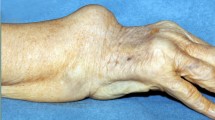Summary
139 limbs from embalmed specimens were dissected to reveal the attachments of extensor muscles in the vicinity of the lateral epicondyle. M. extensor carpi radialis brevis was found to consist of a keelshaped tendon with attachments to m. extensor carpi radialis longus, m. extensor digitorum communis, m. supinator; and to the radial collateral ligament, the orbicular ligament, the capsule of the elbow joint and the deep fascia. On 29 limbs, a prolongation of the muscle was identified attaching proximal to the lateral epicondyle. On nine specimens a bursa was evident between the capsule over the head of the radius and the overlying soft tissues. There was no evidence of variation in vascular or nerve supply to the region. Examination of m. extensor carpi radialis brevis while under tension across the elbow, forearm and wrist revealed the greatest muscle lengthening in pronation of the forearm with palmar flexion and ulnar deviation. The results of this study support the hypothesis that tennis elbow is primarily a mechanically-induced condition. When performing movements at the wrist, with the forearm in pronation, the muscle is at its maximum length. As its origin lies proximal to the axis of rotation for flexion and extension at the elbow, it is subject to shearing stress in all movements of the forearm, especially those involving power at the wrist. This is further compounded by the head of the radius rotating anteriorly against m. extensor carpi radialis brevis during pronation of the forearm. Additionally, a number of individuals may experience pain at the head of the radius during pronation, due to irritation of an underlying bursa.
Résumé
139 membres de sujets anatomiques embaumés ont été disséqués pour déterminer les insertions des muscles extenseurs dans le voisinage de l'épicondyle. Il a été trouvé que le muscle court extenseur radial du carpe avait un tendon en forme de quille de bateau avec des insertions sur les muscles long extenseur radial du carpe, extenseur commun des doigts et supinateur, sur le ligament collatéral radial, sur le ligament annulaire, sur la capsule du coude et l'aponévrose profonde. Sur 29 membres on a trouvé que le muscle court extenseur radial du carpe avait une insertion proximale sur l'épicondyle. Sur 9 pièces il existait une bourse séreuse entre la capsule recouvrant la tête radiale et les tissus de couverture. Il n'est pas apparu nettement de variations vasculaires ou nerveuses dans cette région. L'examen du muscle court extenseur radial du carpe sous étirement a révélé que l'allongement du muscle était maximal quand l'avant-bras était en pronation et la main en flexion palmaire et inclinaison cubitale. Les résultats de cette étude confirment l'hypothèse d'une lésion mécanique primitive à l'origine du Tennis Elbow. Au cours des mouvements du poignet, l'avant-bras en pronation, le muscle s'allonge au maximum. Comme son origine est située proximalement à l'axe de flexion-extension du coude, ce muscle est soumis à des forces de cisaillement dans tous les mouvements de l'avant-bras et plus particulièrement ceux qui exigent de la puissance dans le poignet. Ces effets s'associent ensuite aux frottements de la tête radiale contre le muscle court extenseur radial du carpe lors de la pronation de l'avant-bras. En outre, certains sujets peuvent présenter une douleur au niveau de la tête radiale pendant la pronation du fait d'une irritation de la bourse séreuse avoisinante.
Similar content being viewed by others
References
Bosworth DM (1955) The role of the orbicular ligament in tennis elbow. J Bone Joint Surg 37A: 527–533
Goldie I (1964) Epicondylitis Lateralis Humeri. Epicondylagia or tennis elbow. A pathogenetical study. Acta Chirurgia Scan suppl 339: 1–119
Heyes-Moore GH (1984) Resistant tennis elbow. J Hand Surg 9-B: 64–66
Innes CA (1882) Letter to the Editor, The Lancet, Aug 5, p 210
Kaplan EB (1968) The etiology and treatment of epicondylitis. Bull Hosp Joint Dis 29: 77–83
Morris H (1882) ≪ The Riders Sprain ≫ The Lancet, July 29, p 133
Nirschl RP (1973) Tennis elbow. Orthop Clin North Am 4: 787–800
Nirschl RP, Pettrone FA (1979) Tennis elbow: The surgical treatment of lateral epicondylitis. J Bone Joint Surg 61A: 832–839
Roles NC, Maudsley RH (1972) Radial tunnel syndrome: Resistant tennis elbow as a nerve entrapment. J Bone Joint Surg 54B: 499–508
Runge F (1873) Zur Genese und Behandlung des Schreibekrampfes. Berl Klin Wochenschr 10: 245–248
Stack J (1949) Acute and chronic bursitis in the region of the elbow joint. Surg Clin North Am 29: 155–162
Author information
Authors and Affiliations
Rights and permissions
About this article
Cite this article
Briggs, C.A., Elliott, B.G. Lateral epicondylitis. Anat. Clin 7, 149–153 (1985). https://doi.org/10.1007/BF01654635
Issue Date:
DOI: https://doi.org/10.1007/BF01654635




